Health Care Priority Report: Social Determinants and Health Outcomes
VerifiedAdded on 2023/01/10
|11
|3176
|25
Report
AI Summary
This report delves into the critical aspects of health care priorities, emphasizing the influence of social determinants on health outcomes within the Australian Northern Territory. The analysis incorporates various factors, including socioeconomic structures, local disease prevalence, education ...
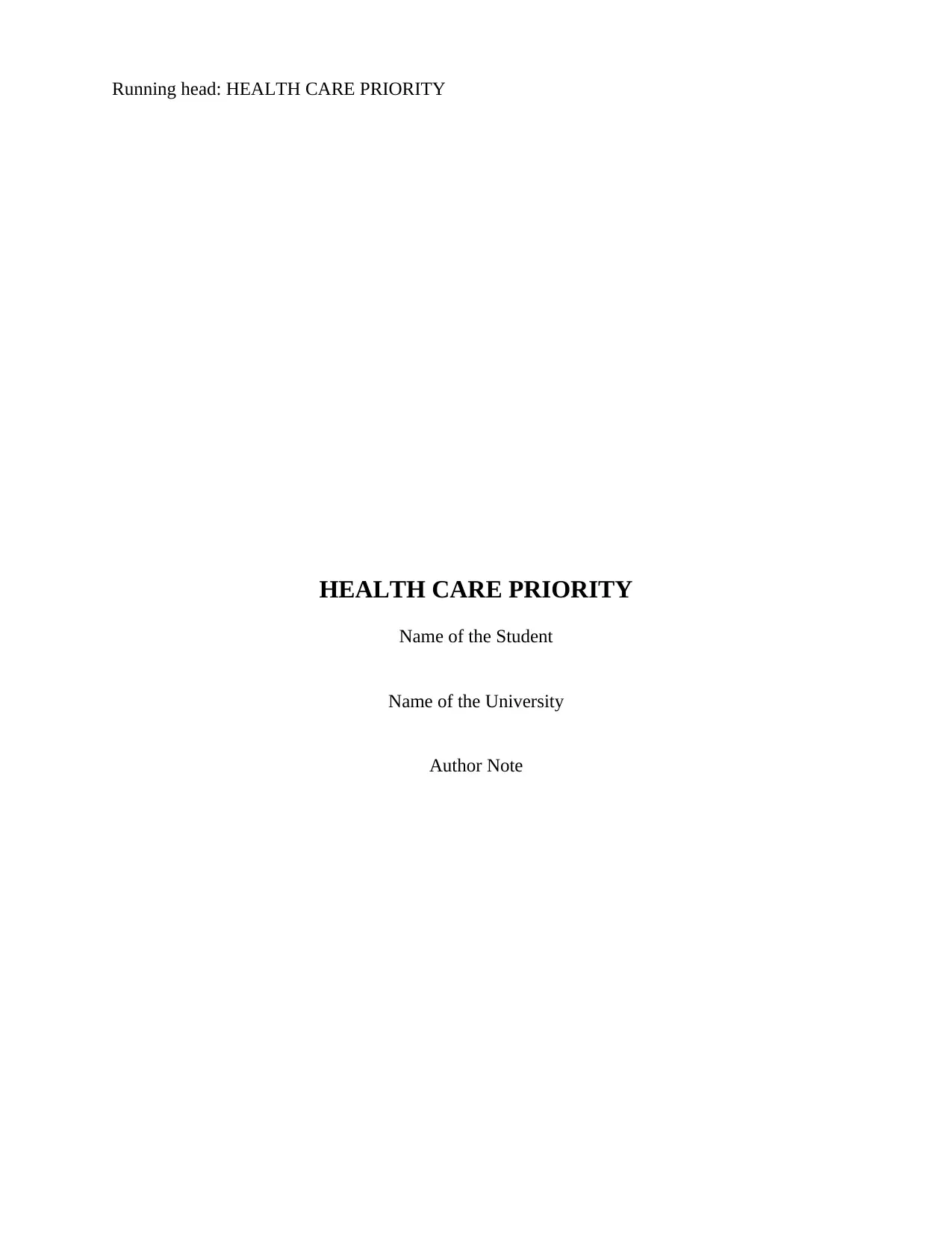
Running head: HEALTH CARE PRIORITY
HEALTH CARE PRIORITY
Name of the Student
Name of the University
Author Note
HEALTH CARE PRIORITY
Name of the Student
Name of the University
Author Note
Paraphrase This Document
Need a fresh take? Get an instant paraphrase of this document with our AI Paraphraser
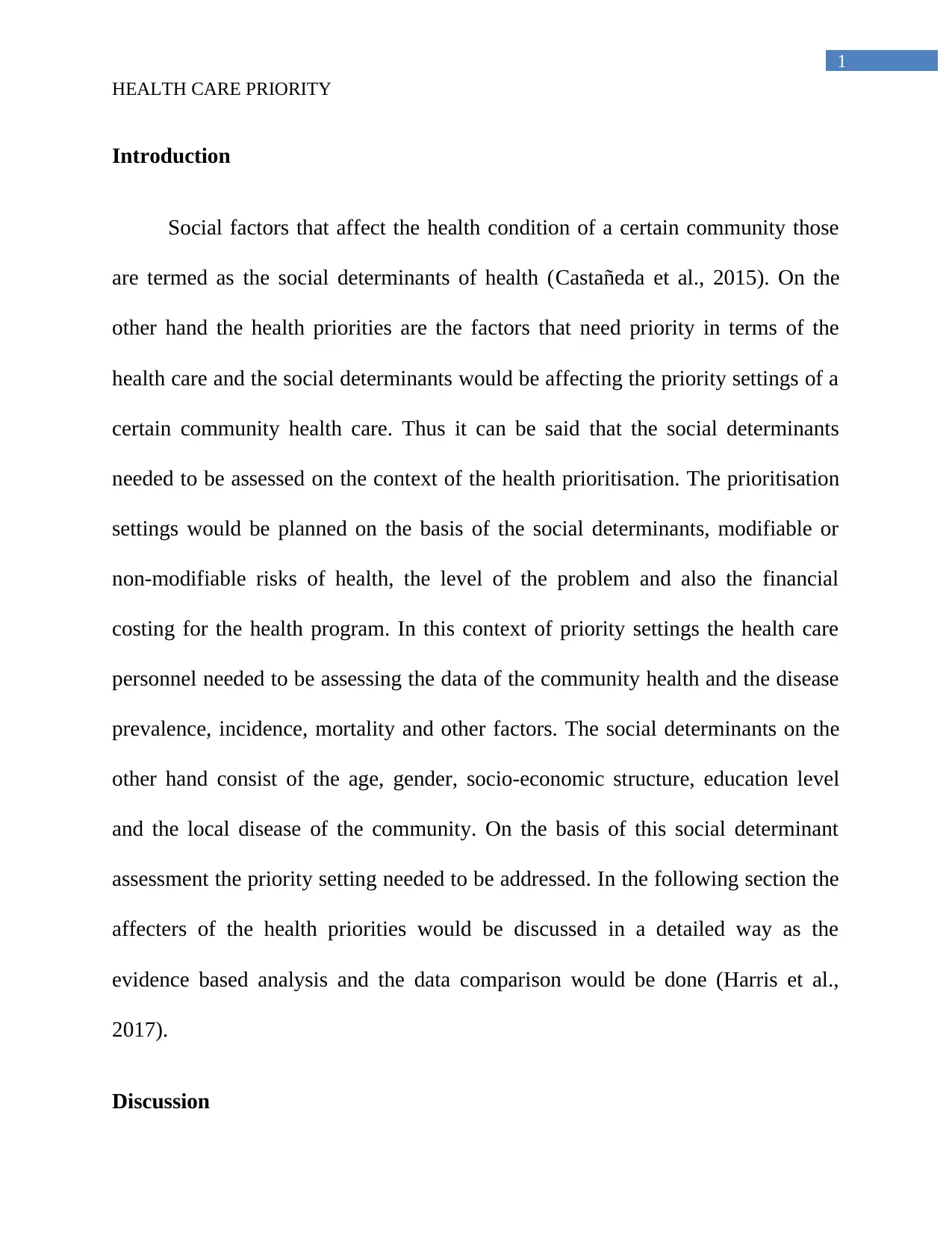
1
HEALTH CARE PRIORITY
Introduction
Social factors that affect the health condition of a certain community those
are termed as the social determinants of health (Castañeda et al., 2015). On the
other hand the health priorities are the factors that need priority in terms of the
health care and the social determinants would be affecting the priority settings of a
certain community health care. Thus it can be said that the social determinants
needed to be assessed on the context of the health prioritisation. The prioritisation
settings would be planned on the basis of the social determinants, modifiable or
non-modifiable risks of health, the level of the problem and also the financial
costing for the health program. In this context of priority settings the health care
personnel needed to be assessing the data of the community health and the disease
prevalence, incidence, mortality and other factors. The social determinants on the
other hand consist of the age, gender, socio-economic structure, education level
and the local disease of the community. On the basis of this social determinant
assessment the priority setting needed to be addressed. In the following section the
affecters of the health priorities would be discussed in a detailed way as the
evidence based analysis and the data comparison would be done (Harris et al.,
2017).
Discussion
HEALTH CARE PRIORITY
Introduction
Social factors that affect the health condition of a certain community those
are termed as the social determinants of health (Castañeda et al., 2015). On the
other hand the health priorities are the factors that need priority in terms of the
health care and the social determinants would be affecting the priority settings of a
certain community health care. Thus it can be said that the social determinants
needed to be assessed on the context of the health prioritisation. The prioritisation
settings would be planned on the basis of the social determinants, modifiable or
non-modifiable risks of health, the level of the problem and also the financial
costing for the health program. In this context of priority settings the health care
personnel needed to be assessing the data of the community health and the disease
prevalence, incidence, mortality and other factors. The social determinants on the
other hand consist of the age, gender, socio-economic structure, education level
and the local disease of the community. On the basis of this social determinant
assessment the priority setting needed to be addressed. In the following section the
affecters of the health priorities would be discussed in a detailed way as the
evidence based analysis and the data comparison would be done (Harris et al.,
2017).
Discussion

2
HEALTH CARE PRIORITY
In the northern territory of Australia the primary social determinants are the socio-
economic structure, local diseases, and lack of education among the population, gender
discrimination and the inability of the aged people. All these factors are consisting of the non-
modifiable risks such as the age and also the health inequality factors as well (Taylor et al.,
2016). The northern community of Australia in the Victoria it is found the socio-economic
factors are the one of the most prevailed problem as the unequal economic structure leads to the
lack of the access to the health care setup of the area by a large number of people affects the
health priority of the area. According to Viergever et al., (2010), the checklist of the priority
setup depends on the nine common themes such as the context, use of comprehensive approach,
inclusiveness, information gathering, planning for implementation, deciding criteria, methods of
decision, evaluation and transparency. On this approach the context can be termed as the
assessing factor for the social determinants of health, use of comprehensive approach helps in the
comprehensive approach to the research process or own method would be chosen by the health
care professional, information gathering helps in the appropriate inform gathering on the basis of
the assessments. Whereas the planning depends on all the above mentioned factors the priority
setting research method and the decision also partially depends on these factors. However, the
data collection, research method and the assessment of the problem helps in the evaluation of the
detection of the priority setting and on all these factors and the transparency would be taken in
account for the report writing for the priority factor setup. Persad, Wertheimer and Emanuel,
(2009), highlighted that the allocation of the very scarce intervention would be dependent on the
assessment of the priority problem and the allocation of scarce medication or other treatment
processes would be needed for the northern area of the Australia including Victoria. The socio-
economic structure and the unequal age and gender distribution in the area need the allocation of
HEALTH CARE PRIORITY
In the northern territory of Australia the primary social determinants are the socio-
economic structure, local diseases, and lack of education among the population, gender
discrimination and the inability of the aged people. All these factors are consisting of the non-
modifiable risks such as the age and also the health inequality factors as well (Taylor et al.,
2016). The northern community of Australia in the Victoria it is found the socio-economic
factors are the one of the most prevailed problem as the unequal economic structure leads to the
lack of the access to the health care setup of the area by a large number of people affects the
health priority of the area. According to Viergever et al., (2010), the checklist of the priority
setup depends on the nine common themes such as the context, use of comprehensive approach,
inclusiveness, information gathering, planning for implementation, deciding criteria, methods of
decision, evaluation and transparency. On this approach the context can be termed as the
assessing factor for the social determinants of health, use of comprehensive approach helps in the
comprehensive approach to the research process or own method would be chosen by the health
care professional, information gathering helps in the appropriate inform gathering on the basis of
the assessments. Whereas the planning depends on all the above mentioned factors the priority
setting research method and the decision also partially depends on these factors. However, the
data collection, research method and the assessment of the problem helps in the evaluation of the
detection of the priority setting and on all these factors and the transparency would be taken in
account for the report writing for the priority factor setup. Persad, Wertheimer and Emanuel,
(2009), highlighted that the allocation of the very scarce intervention would be dependent on the
assessment of the priority problem and the allocation of scarce medication or other treatment
processes would be needed for the northern area of the Australia including Victoria. The socio-
economic structure and the unequal age and gender distribution in the area need the allocation of
You're viewing a preview
Unlock full access by subscribing today!
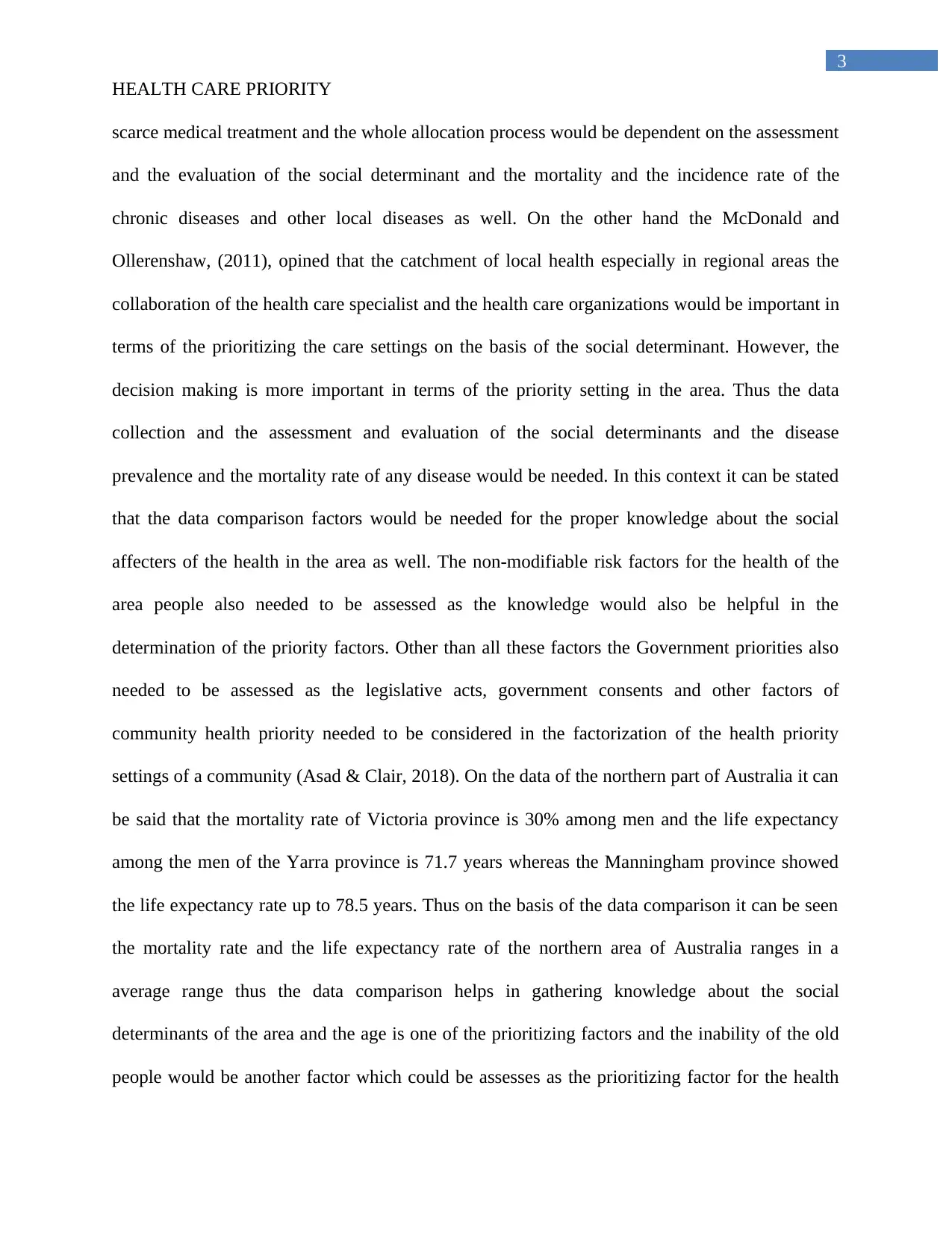
3
HEALTH CARE PRIORITY
scarce medical treatment and the whole allocation process would be dependent on the assessment
and the evaluation of the social determinant and the mortality and the incidence rate of the
chronic diseases and other local diseases as well. On the other hand the McDonald and
Ollerenshaw, (2011), opined that the catchment of local health especially in regional areas the
collaboration of the health care specialist and the health care organizations would be important in
terms of the prioritizing the care settings on the basis of the social determinant. However, the
decision making is more important in terms of the priority setting in the area. Thus the data
collection and the assessment and evaluation of the social determinants and the disease
prevalence and the mortality rate of any disease would be needed. In this context it can be stated
that the data comparison factors would be needed for the proper knowledge about the social
affecters of the health in the area as well. The non-modifiable risk factors for the health of the
area people also needed to be assessed as the knowledge would also be helpful in the
determination of the priority factors. Other than all these factors the Government priorities also
needed to be assessed as the legislative acts, government consents and other factors of
community health priority needed to be considered in the factorization of the health priority
settings of a community (Asad & Clair, 2018). On the data of the northern part of Australia it can
be said that the mortality rate of Victoria province is 30% among men and the life expectancy
among the men of the Yarra province is 71.7 years whereas the Manningham province showed
the life expectancy rate up to 78.5 years. Thus on the basis of the data comparison it can be seen
the mortality rate and the life expectancy rate of the northern area of Australia ranges in a
average range thus the data comparison helps in gathering knowledge about the social
determinants of the area and the age is one of the prioritizing factors and the inability of the old
people would be another factor which could be assesses as the prioritizing factor for the health
HEALTH CARE PRIORITY
scarce medical treatment and the whole allocation process would be dependent on the assessment
and the evaluation of the social determinant and the mortality and the incidence rate of the
chronic diseases and other local diseases as well. On the other hand the McDonald and
Ollerenshaw, (2011), opined that the catchment of local health especially in regional areas the
collaboration of the health care specialist and the health care organizations would be important in
terms of the prioritizing the care settings on the basis of the social determinant. However, the
decision making is more important in terms of the priority setting in the area. Thus the data
collection and the assessment and evaluation of the social determinants and the disease
prevalence and the mortality rate of any disease would be needed. In this context it can be stated
that the data comparison factors would be needed for the proper knowledge about the social
affecters of the health in the area as well. The non-modifiable risk factors for the health of the
area people also needed to be assessed as the knowledge would also be helpful in the
determination of the priority factors. Other than all these factors the Government priorities also
needed to be assessed as the legislative acts, government consents and other factors of
community health priority needed to be considered in the factorization of the health priority
settings of a community (Asad & Clair, 2018). On the data of the northern part of Australia it can
be said that the mortality rate of Victoria province is 30% among men and the life expectancy
among the men of the Yarra province is 71.7 years whereas the Manningham province showed
the life expectancy rate up to 78.5 years. Thus on the basis of the data comparison it can be seen
the mortality rate and the life expectancy rate of the northern area of Australia ranges in a
average range thus the data comparison helps in gathering knowledge about the social
determinants of the area and the age is one of the prioritizing factors and the inability of the old
people would be another factor which could be assesses as the prioritizing factor for the health
Paraphrase This Document
Need a fresh take? Get an instant paraphrase of this document with our AI Paraphraser
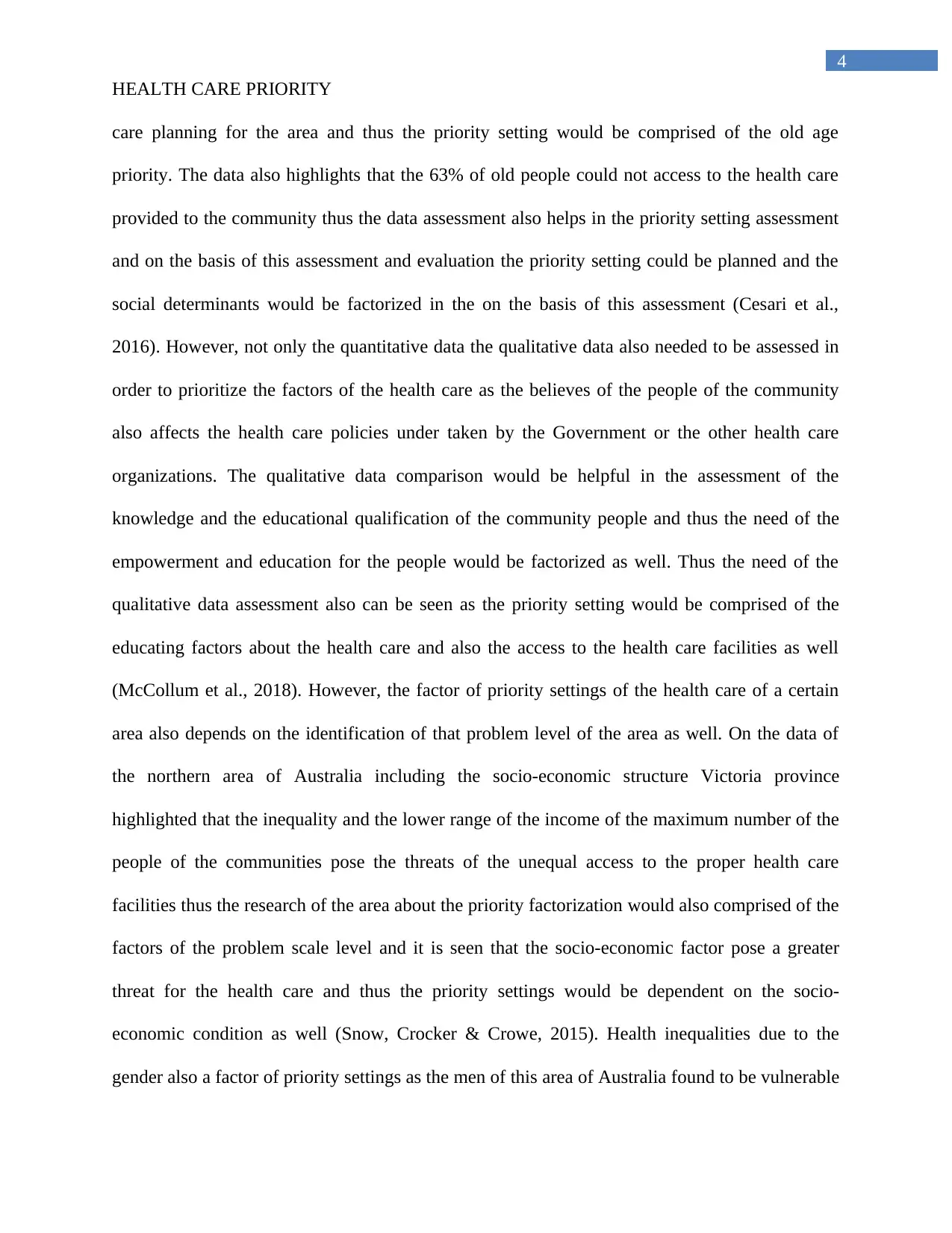
4
HEALTH CARE PRIORITY
care planning for the area and thus the priority setting would be comprised of the old age
priority. The data also highlights that the 63% of old people could not access to the health care
provided to the community thus the data assessment also helps in the priority setting assessment
and on the basis of this assessment and evaluation the priority setting could be planned and the
social determinants would be factorized in the on the basis of this assessment (Cesari et al.,
2016). However, not only the quantitative data the qualitative data also needed to be assessed in
order to prioritize the factors of the health care as the believes of the people of the community
also affects the health care policies under taken by the Government or the other health care
organizations. The qualitative data comparison would be helpful in the assessment of the
knowledge and the educational qualification of the community people and thus the need of the
empowerment and education for the people would be factorized as well. Thus the need of the
qualitative data assessment also can be seen as the priority setting would be comprised of the
educating factors about the health care and also the access to the health care facilities as well
(McCollum et al., 2018). However, the factor of priority settings of the health care of a certain
area also depends on the identification of that problem level of the area as well. On the data of
the northern area of Australia including the socio-economic structure Victoria province
highlighted that the inequality and the lower range of the income of the maximum number of the
people of the communities pose the threats of the unequal access to the proper health care
facilities thus the research of the area about the priority factorization would also comprised of the
factors of the problem scale level and it is seen that the socio-economic factor pose a greater
threat for the health care and thus the priority settings would be dependent on the socio-
economic condition as well (Snow, Crocker & Crowe, 2015). Health inequalities due to the
gender also a factor of priority settings as the men of this area of Australia found to be vulnerable
HEALTH CARE PRIORITY
care planning for the area and thus the priority setting would be comprised of the old age
priority. The data also highlights that the 63% of old people could not access to the health care
provided to the community thus the data assessment also helps in the priority setting assessment
and on the basis of this assessment and evaluation the priority setting could be planned and the
social determinants would be factorized in the on the basis of this assessment (Cesari et al.,
2016). However, not only the quantitative data the qualitative data also needed to be assessed in
order to prioritize the factors of the health care as the believes of the people of the community
also affects the health care policies under taken by the Government or the other health care
organizations. The qualitative data comparison would be helpful in the assessment of the
knowledge and the educational qualification of the community people and thus the need of the
empowerment and education for the people would be factorized as well. Thus the need of the
qualitative data assessment also can be seen as the priority setting would be comprised of the
educating factors about the health care and also the access to the health care facilities as well
(McCollum et al., 2018). However, the factor of priority settings of the health care of a certain
area also depends on the identification of that problem level of the area as well. On the data of
the northern area of Australia including the socio-economic structure Victoria province
highlighted that the inequality and the lower range of the income of the maximum number of the
people of the communities pose the threats of the unequal access to the proper health care
facilities thus the research of the area about the priority factorization would also comprised of the
factors of the problem scale level and it is seen that the socio-economic factor pose a greater
threat for the health care and thus the priority settings would be dependent on the socio-
economic condition as well (Snow, Crocker & Crowe, 2015). Health inequalities due to the
gender also a factor of priority settings as the men of this area of Australia found to be vulnerable
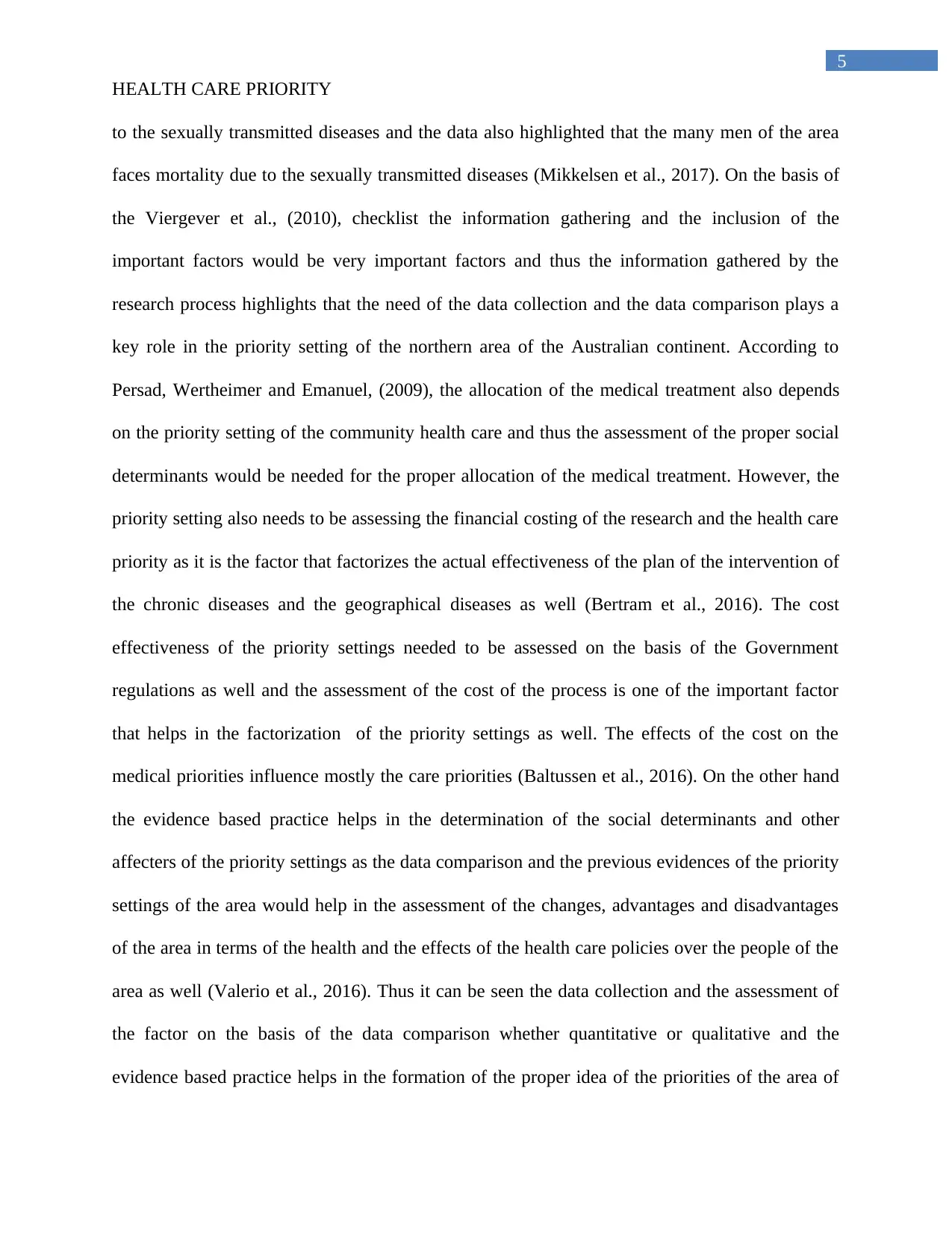
5
HEALTH CARE PRIORITY
to the sexually transmitted diseases and the data also highlighted that the many men of the area
faces mortality due to the sexually transmitted diseases (Mikkelsen et al., 2017). On the basis of
the Viergever et al., (2010), checklist the information gathering and the inclusion of the
important factors would be very important factors and thus the information gathered by the
research process highlights that the need of the data collection and the data comparison plays a
key role in the priority setting of the northern area of the Australian continent. According to
Persad, Wertheimer and Emanuel, (2009), the allocation of the medical treatment also depends
on the priority setting of the community health care and thus the assessment of the proper social
determinants would be needed for the proper allocation of the medical treatment. However, the
priority setting also needs to be assessing the financial costing of the research and the health care
priority as it is the factor that factorizes the actual effectiveness of the plan of the intervention of
the chronic diseases and the geographical diseases as well (Bertram et al., 2016). The cost
effectiveness of the priority settings needed to be assessed on the basis of the Government
regulations as well and the assessment of the cost of the process is one of the important factor
that helps in the factorization of the priority settings as well. The effects of the cost on the
medical priorities influence mostly the care priorities (Baltussen et al., 2016). On the other hand
the evidence based practice helps in the determination of the social determinants and other
affecters of the priority settings as the data comparison and the previous evidences of the priority
settings of the area would help in the assessment of the changes, advantages and disadvantages
of the area in terms of the health and the effects of the health care policies over the people of the
area as well (Valerio et al., 2016). Thus it can be seen the data collection and the assessment of
the factor on the basis of the data comparison whether quantitative or qualitative and the
evidence based practice helps in the formation of the proper idea of the priorities of the area of
HEALTH CARE PRIORITY
to the sexually transmitted diseases and the data also highlighted that the many men of the area
faces mortality due to the sexually transmitted diseases (Mikkelsen et al., 2017). On the basis of
the Viergever et al., (2010), checklist the information gathering and the inclusion of the
important factors would be very important factors and thus the information gathered by the
research process highlights that the need of the data collection and the data comparison plays a
key role in the priority setting of the northern area of the Australian continent. According to
Persad, Wertheimer and Emanuel, (2009), the allocation of the medical treatment also depends
on the priority setting of the community health care and thus the assessment of the proper social
determinants would be needed for the proper allocation of the medical treatment. However, the
priority setting also needs to be assessing the financial costing of the research and the health care
priority as it is the factor that factorizes the actual effectiveness of the plan of the intervention of
the chronic diseases and the geographical diseases as well (Bertram et al., 2016). The cost
effectiveness of the priority settings needed to be assessed on the basis of the Government
regulations as well and the assessment of the cost of the process is one of the important factor
that helps in the factorization of the priority settings as well. The effects of the cost on the
medical priorities influence mostly the care priorities (Baltussen et al., 2016). On the other hand
the evidence based practice helps in the determination of the social determinants and other
affecters of the priority settings as the data comparison and the previous evidences of the priority
settings of the area would help in the assessment of the changes, advantages and disadvantages
of the area in terms of the health and the effects of the health care policies over the people of the
area as well (Valerio et al., 2016). Thus it can be seen the data collection and the assessment of
the factor on the basis of the data comparison whether quantitative or qualitative and the
evidence based practice helps in the formation of the proper idea of the priorities of the area of
You're viewing a preview
Unlock full access by subscribing today!
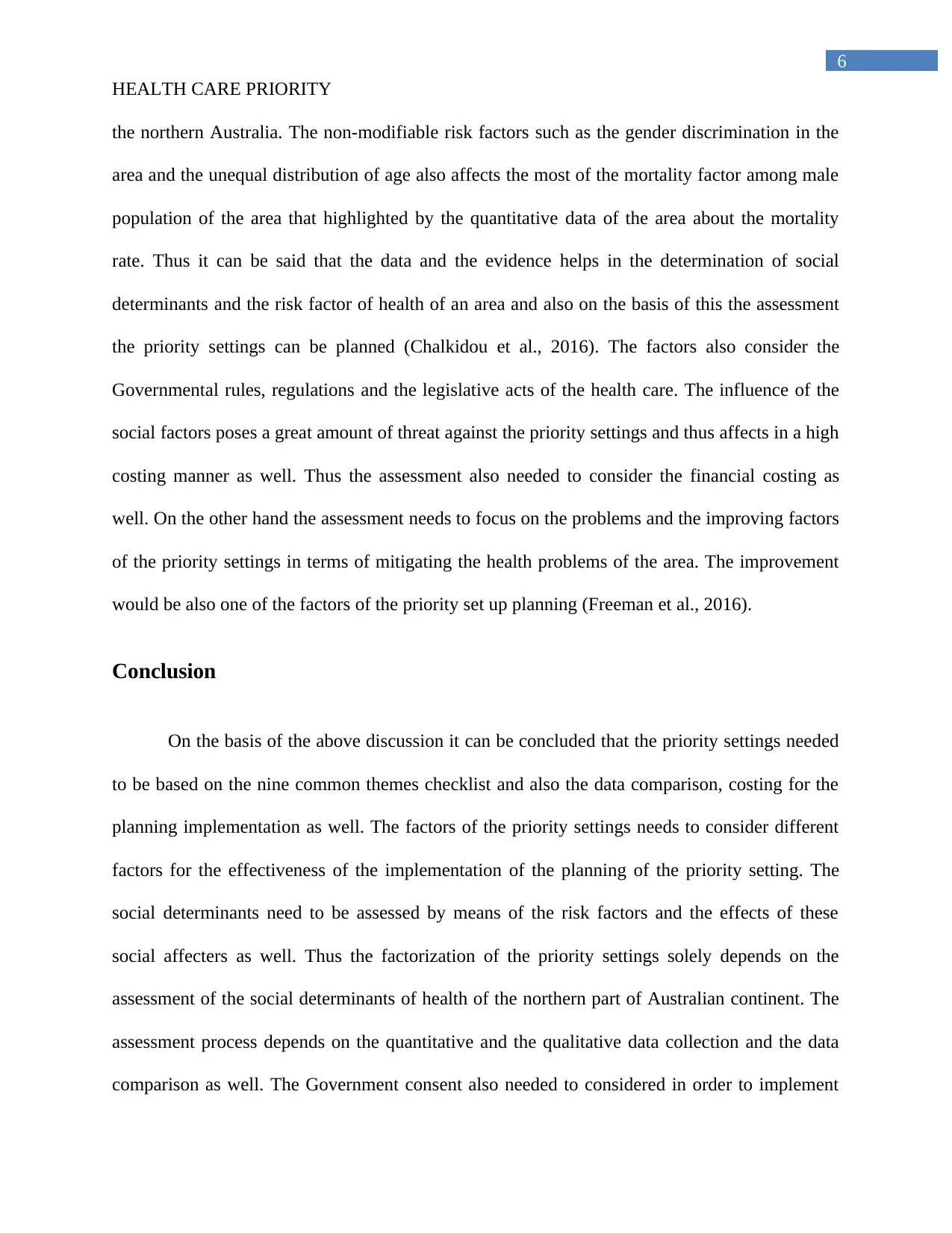
6
HEALTH CARE PRIORITY
the northern Australia. The non-modifiable risk factors such as the gender discrimination in the
area and the unequal distribution of age also affects the most of the mortality factor among male
population of the area that highlighted by the quantitative data of the area about the mortality
rate. Thus it can be said that the data and the evidence helps in the determination of social
determinants and the risk factor of health of an area and also on the basis of this the assessment
the priority settings can be planned (Chalkidou et al., 2016). The factors also consider the
Governmental rules, regulations and the legislative acts of the health care. The influence of the
social factors poses a great amount of threat against the priority settings and thus affects in a high
costing manner as well. Thus the assessment also needed to consider the financial costing as
well. On the other hand the assessment needs to focus on the problems and the improving factors
of the priority settings in terms of mitigating the health problems of the area. The improvement
would be also one of the factors of the priority set up planning (Freeman et al., 2016).
Conclusion
On the basis of the above discussion it can be concluded that the priority settings needed
to be based on the nine common themes checklist and also the data comparison, costing for the
planning implementation as well. The factors of the priority settings needs to consider different
factors for the effectiveness of the implementation of the planning of the priority setting. The
social determinants need to be assessed by means of the risk factors and the effects of these
social affecters as well. Thus the factorization of the priority settings solely depends on the
assessment of the social determinants of health of the northern part of Australian continent. The
assessment process depends on the quantitative and the qualitative data collection and the data
comparison as well. The Government consent also needed to considered in order to implement
HEALTH CARE PRIORITY
the northern Australia. The non-modifiable risk factors such as the gender discrimination in the
area and the unequal distribution of age also affects the most of the mortality factor among male
population of the area that highlighted by the quantitative data of the area about the mortality
rate. Thus it can be said that the data and the evidence helps in the determination of social
determinants and the risk factor of health of an area and also on the basis of this the assessment
the priority settings can be planned (Chalkidou et al., 2016). The factors also consider the
Governmental rules, regulations and the legislative acts of the health care. The influence of the
social factors poses a great amount of threat against the priority settings and thus affects in a high
costing manner as well. Thus the assessment also needed to consider the financial costing as
well. On the other hand the assessment needs to focus on the problems and the improving factors
of the priority settings in terms of mitigating the health problems of the area. The improvement
would be also one of the factors of the priority set up planning (Freeman et al., 2016).
Conclusion
On the basis of the above discussion it can be concluded that the priority settings needed
to be based on the nine common themes checklist and also the data comparison, costing for the
planning implementation as well. The factors of the priority settings needs to consider different
factors for the effectiveness of the implementation of the planning of the priority setting. The
social determinants need to be assessed by means of the risk factors and the effects of these
social affecters as well. Thus the factorization of the priority settings solely depends on the
assessment of the social determinants of health of the northern part of Australian continent. The
assessment process depends on the quantitative and the qualitative data collection and the data
comparison as well. The Government consent also needed to considered in order to implement
Paraphrase This Document
Need a fresh take? Get an instant paraphrase of this document with our AI Paraphraser
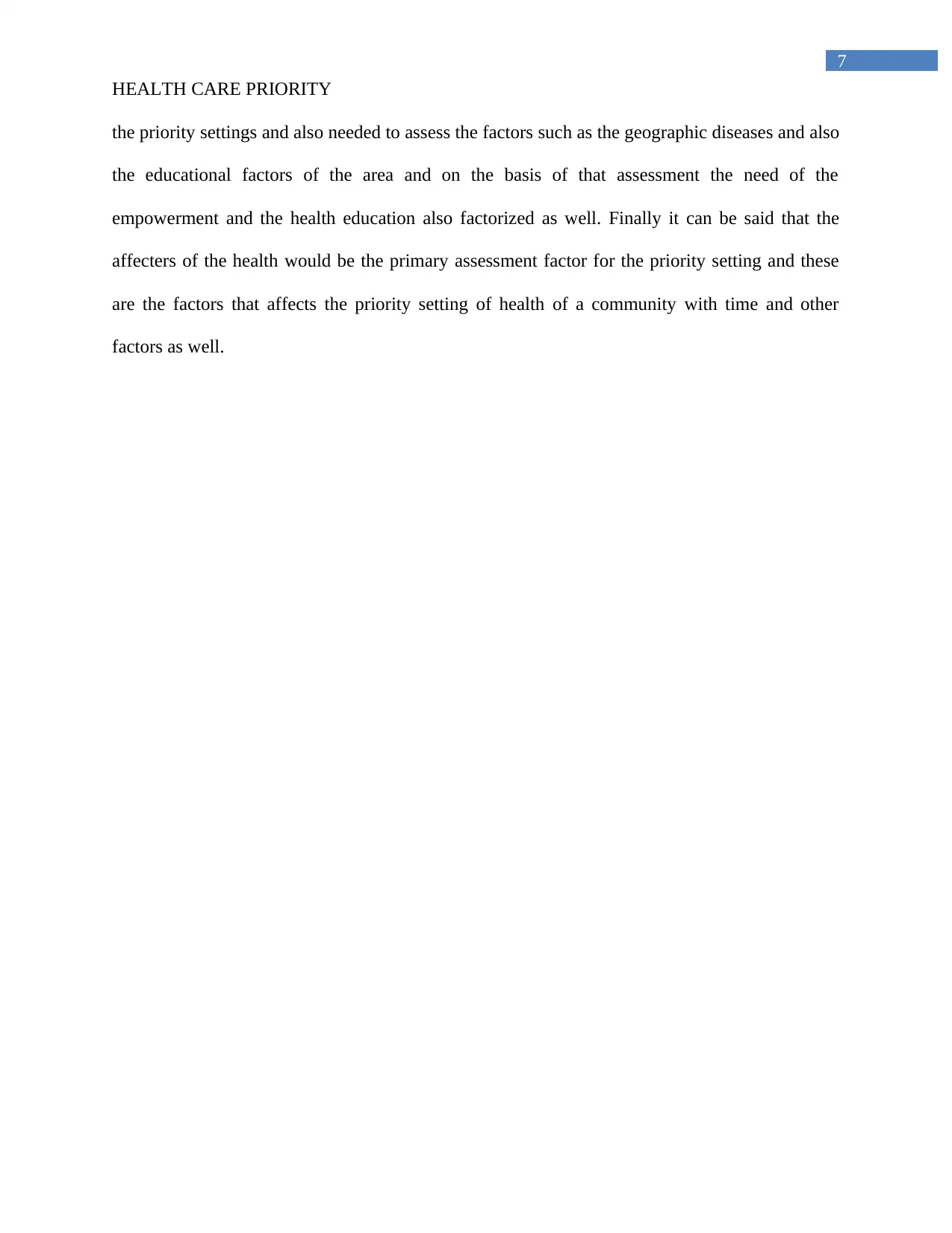
7
HEALTH CARE PRIORITY
the priority settings and also needed to assess the factors such as the geographic diseases and also
the educational factors of the area and on the basis of that assessment the need of the
empowerment and the health education also factorized as well. Finally it can be said that the
affecters of the health would be the primary assessment factor for the priority setting and these
are the factors that affects the priority setting of health of a community with time and other
factors as well.
HEALTH CARE PRIORITY
the priority settings and also needed to assess the factors such as the geographic diseases and also
the educational factors of the area and on the basis of that assessment the need of the
empowerment and the health education also factorized as well. Finally it can be said that the
affecters of the health would be the primary assessment factor for the priority setting and these
are the factors that affects the priority setting of health of a community with time and other
factors as well.
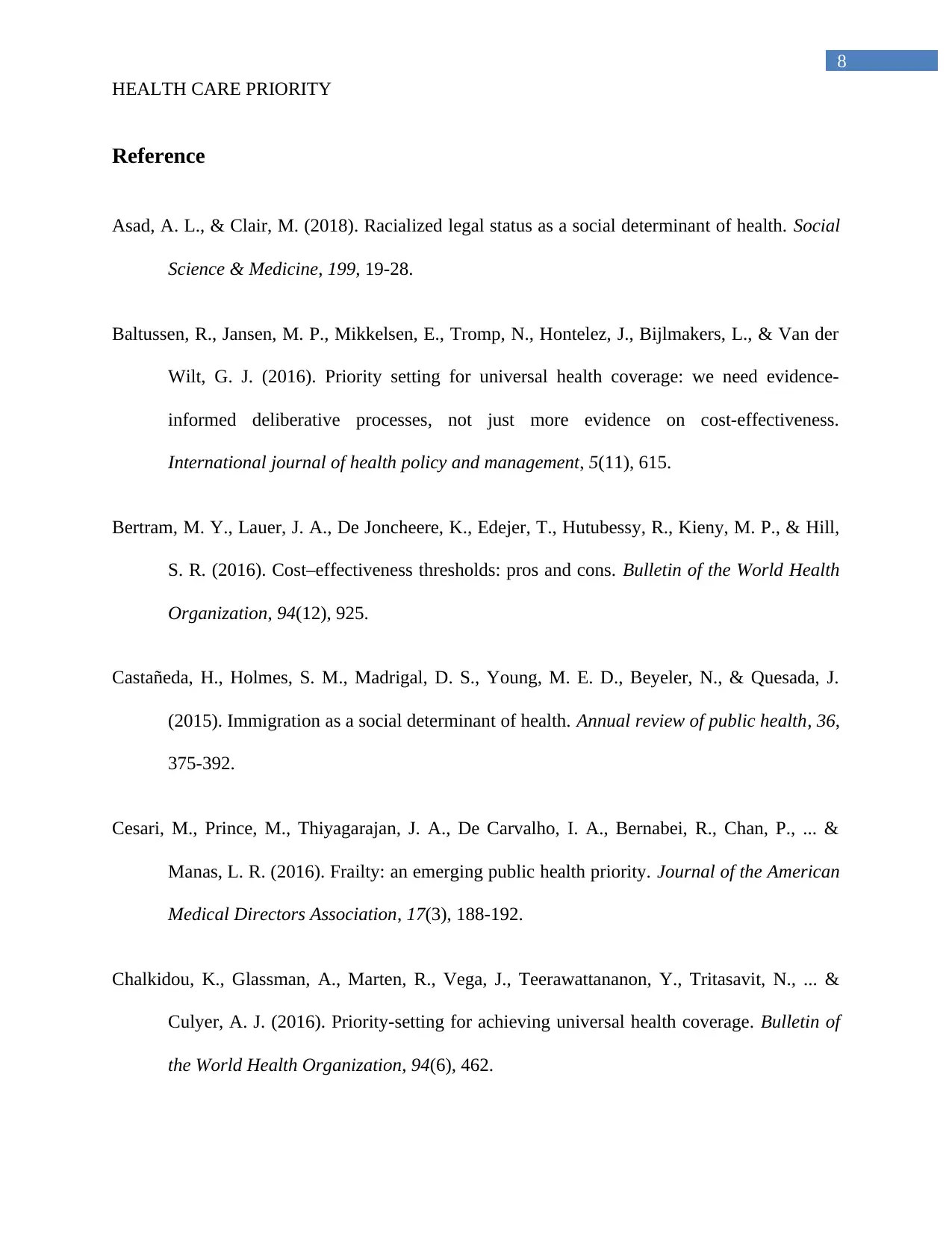
8
HEALTH CARE PRIORITY
Reference
Asad, A. L., & Clair, M. (2018). Racialized legal status as a social determinant of health. Social
Science & Medicine, 199, 19-28.
Baltussen, R., Jansen, M. P., Mikkelsen, E., Tromp, N., Hontelez, J., Bijlmakers, L., & Van der
Wilt, G. J. (2016). Priority setting for universal health coverage: we need evidence-
informed deliberative processes, not just more evidence on cost-effectiveness.
International journal of health policy and management, 5(11), 615.
Bertram, M. Y., Lauer, J. A., De Joncheere, K., Edejer, T., Hutubessy, R., Kieny, M. P., & Hill,
S. R. (2016). Cost–effectiveness thresholds: pros and cons. Bulletin of the World Health
Organization, 94(12), 925.
Castañeda, H., Holmes, S. M., Madrigal, D. S., Young, M. E. D., Beyeler, N., & Quesada, J.
(2015). Immigration as a social determinant of health. Annual review of public health, 36,
375-392.
Cesari, M., Prince, M., Thiyagarajan, J. A., De Carvalho, I. A., Bernabei, R., Chan, P., ... &
Manas, L. R. (2016). Frailty: an emerging public health priority. Journal of the American
Medical Directors Association, 17(3), 188-192.
Chalkidou, K., Glassman, A., Marten, R., Vega, J., Teerawattananon, Y., Tritasavit, N., ... &
Culyer, A. J. (2016). Priority-setting for achieving universal health coverage. Bulletin of
the World Health Organization, 94(6), 462.
HEALTH CARE PRIORITY
Reference
Asad, A. L., & Clair, M. (2018). Racialized legal status as a social determinant of health. Social
Science & Medicine, 199, 19-28.
Baltussen, R., Jansen, M. P., Mikkelsen, E., Tromp, N., Hontelez, J., Bijlmakers, L., & Van der
Wilt, G. J. (2016). Priority setting for universal health coverage: we need evidence-
informed deliberative processes, not just more evidence on cost-effectiveness.
International journal of health policy and management, 5(11), 615.
Bertram, M. Y., Lauer, J. A., De Joncheere, K., Edejer, T., Hutubessy, R., Kieny, M. P., & Hill,
S. R. (2016). Cost–effectiveness thresholds: pros and cons. Bulletin of the World Health
Organization, 94(12), 925.
Castañeda, H., Holmes, S. M., Madrigal, D. S., Young, M. E. D., Beyeler, N., & Quesada, J.
(2015). Immigration as a social determinant of health. Annual review of public health, 36,
375-392.
Cesari, M., Prince, M., Thiyagarajan, J. A., De Carvalho, I. A., Bernabei, R., Chan, P., ... &
Manas, L. R. (2016). Frailty: an emerging public health priority. Journal of the American
Medical Directors Association, 17(3), 188-192.
Chalkidou, K., Glassman, A., Marten, R., Vega, J., Teerawattananon, Y., Tritasavit, N., ... &
Culyer, A. J. (2016). Priority-setting for achieving universal health coverage. Bulletin of
the World Health Organization, 94(6), 462.
You're viewing a preview
Unlock full access by subscribing today!
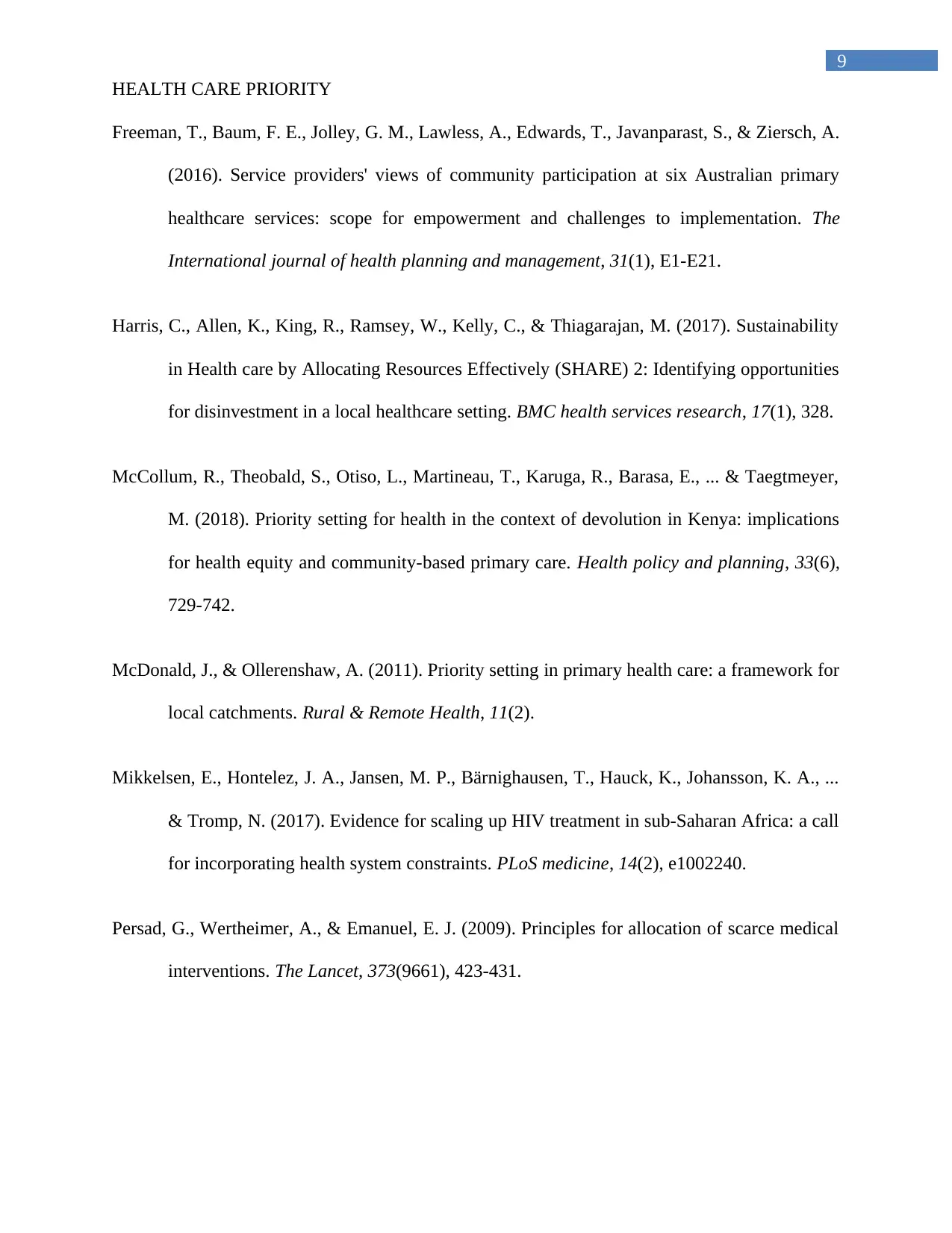
9
HEALTH CARE PRIORITY
Freeman, T., Baum, F. E., Jolley, G. M., Lawless, A., Edwards, T., Javanparast, S., & Ziersch, A.
(2016). Service providers' views of community participation at six Australian primary
healthcare services: scope for empowerment and challenges to implementation. The
International journal of health planning and management, 31(1), E1-E21.
Harris, C., Allen, K., King, R., Ramsey, W., Kelly, C., & Thiagarajan, M. (2017). Sustainability
in Health care by Allocating Resources Effectively (SHARE) 2: Identifying opportunities
for disinvestment in a local healthcare setting. BMC health services research, 17(1), 328.
McCollum, R., Theobald, S., Otiso, L., Martineau, T., Karuga, R., Barasa, E., ... & Taegtmeyer,
M. (2018). Priority setting for health in the context of devolution in Kenya: implications
for health equity and community-based primary care. Health policy and planning, 33(6),
729-742.
McDonald, J., & Ollerenshaw, A. (2011). Priority setting in primary health care: a framework for
local catchments. Rural & Remote Health, 11(2).
Mikkelsen, E., Hontelez, J. A., Jansen, M. P., Bärnighausen, T., Hauck, K., Johansson, K. A., ...
& Tromp, N. (2017). Evidence for scaling up HIV treatment in sub-Saharan Africa: a call
for incorporating health system constraints. PLoS medicine, 14(2), e1002240.
Persad, G., Wertheimer, A., & Emanuel, E. J. (2009). Principles for allocation of scarce medical
interventions. The Lancet, 373(9661), 423-431.
HEALTH CARE PRIORITY
Freeman, T., Baum, F. E., Jolley, G. M., Lawless, A., Edwards, T., Javanparast, S., & Ziersch, A.
(2016). Service providers' views of community participation at six Australian primary
healthcare services: scope for empowerment and challenges to implementation. The
International journal of health planning and management, 31(1), E1-E21.
Harris, C., Allen, K., King, R., Ramsey, W., Kelly, C., & Thiagarajan, M. (2017). Sustainability
in Health care by Allocating Resources Effectively (SHARE) 2: Identifying opportunities
for disinvestment in a local healthcare setting. BMC health services research, 17(1), 328.
McCollum, R., Theobald, S., Otiso, L., Martineau, T., Karuga, R., Barasa, E., ... & Taegtmeyer,
M. (2018). Priority setting for health in the context of devolution in Kenya: implications
for health equity and community-based primary care. Health policy and planning, 33(6),
729-742.
McDonald, J., & Ollerenshaw, A. (2011). Priority setting in primary health care: a framework for
local catchments. Rural & Remote Health, 11(2).
Mikkelsen, E., Hontelez, J. A., Jansen, M. P., Bärnighausen, T., Hauck, K., Johansson, K. A., ...
& Tromp, N. (2017). Evidence for scaling up HIV treatment in sub-Saharan Africa: a call
for incorporating health system constraints. PLoS medicine, 14(2), e1002240.
Persad, G., Wertheimer, A., & Emanuel, E. J. (2009). Principles for allocation of scarce medical
interventions. The Lancet, 373(9661), 423-431.
Paraphrase This Document
Need a fresh take? Get an instant paraphrase of this document with our AI Paraphraser
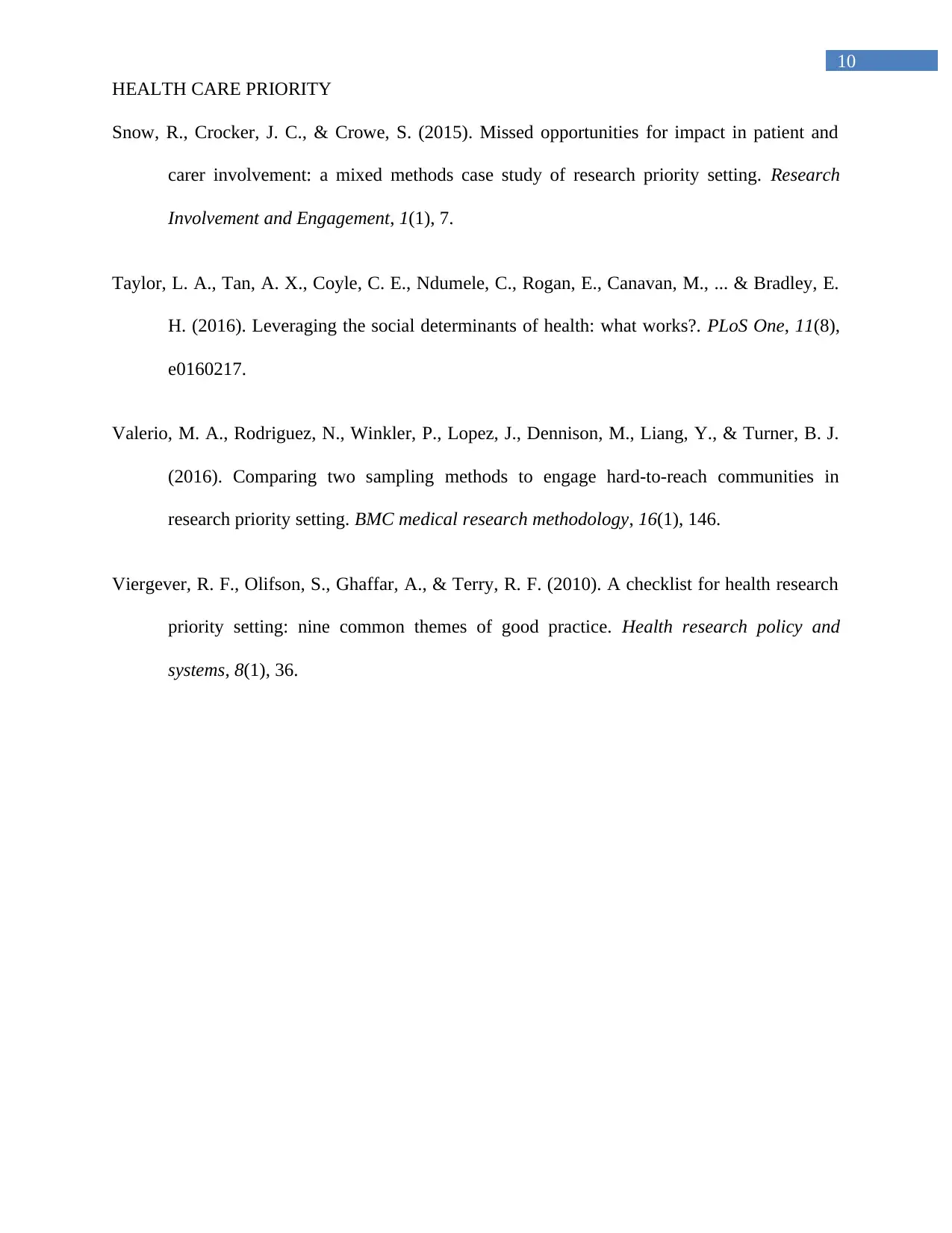
10
HEALTH CARE PRIORITY
Snow, R., Crocker, J. C., & Crowe, S. (2015). Missed opportunities for impact in patient and
carer involvement: a mixed methods case study of research priority setting. Research
Involvement and Engagement, 1(1), 7.
Taylor, L. A., Tan, A. X., Coyle, C. E., Ndumele, C., Rogan, E., Canavan, M., ... & Bradley, E.
H. (2016). Leveraging the social determinants of health: what works?. PLoS One, 11(8),
e0160217.
Valerio, M. A., Rodriguez, N., Winkler, P., Lopez, J., Dennison, M., Liang, Y., & Turner, B. J.
(2016). Comparing two sampling methods to engage hard-to-reach communities in
research priority setting. BMC medical research methodology, 16(1), 146.
Viergever, R. F., Olifson, S., Ghaffar, A., & Terry, R. F. (2010). A checklist for health research
priority setting: nine common themes of good practice. Health research policy and
systems, 8(1), 36.
HEALTH CARE PRIORITY
Snow, R., Crocker, J. C., & Crowe, S. (2015). Missed opportunities for impact in patient and
carer involvement: a mixed methods case study of research priority setting. Research
Involvement and Engagement, 1(1), 7.
Taylor, L. A., Tan, A. X., Coyle, C. E., Ndumele, C., Rogan, E., Canavan, M., ... & Bradley, E.
H. (2016). Leveraging the social determinants of health: what works?. PLoS One, 11(8),
e0160217.
Valerio, M. A., Rodriguez, N., Winkler, P., Lopez, J., Dennison, M., Liang, Y., & Turner, B. J.
(2016). Comparing two sampling methods to engage hard-to-reach communities in
research priority setting. BMC medical research methodology, 16(1), 146.
Viergever, R. F., Olifson, S., Ghaffar, A., & Terry, R. F. (2010). A checklist for health research
priority setting: nine common themes of good practice. Health research policy and
systems, 8(1), 36.
1 out of 11
Related Documents
Your All-in-One AI-Powered Toolkit for Academic Success.
+13062052269
info@desklib.com
Available 24*7 on WhatsApp / Email
![[object Object]](/_next/static/media/star-bottom.7253800d.svg)
Unlock your academic potential
© 2024 | Zucol Services PVT LTD | All rights reserved.





